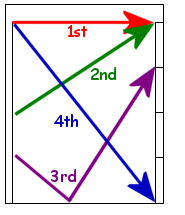





"Chinese is a tonal language."
This sentence has confounded millions of you, no doubt. To clarify, we don't mean that pronouncing the same word, or character, in different tones affects its meaning.
Instead, we mean that the tone for each Chinese character is, for lack of a better word, assigned.
Mandarin has four tones--five if you count the "neutral" tone--and as you'll see below, pronouncing the tone just right is very important.
 Written
characters don't reveal their initials and finals, nor do they indicate which
tones they are to be pronounced in.
Written
characters don't reveal their initials and finals, nor do they indicate which
tones they are to be pronounced in.
Tones also have nothing to do with parts of speech or any other variable. Each character's "assigned" tone is simply learned when you study or "acquire" Chinese.
The four tones are usually depicted graphically with the accompanying chart, to show "where" each one occurs in tonal space.
The following table illustrates tone markings above the sound ma and describes how each tone is vocalized:
| Tone |
Mark |
Description |
| 1st |
|
High and level. |
| 2nd |
|
Starts medium in tone, then rises to the top. |
| 3rd |
|
Starts low, dips to the bottom, then rises toward the top. |
| 4th |
|
Starts at the top, then falls sharp and strong to the bottom. |
| neutral |
|
Flat, with no emphasis. |
Here are a couple points to keep in mind as you soak in the table just above:
And this is very important: If you use the wrong tones, your listeners may not be able to understand you. Those of us who studied Chinese in Chinese-speaking regions remember quite well the frustration of not being understood early on simply because our tones were a little off.
EXAMPLEThese misunderstandings are possible because some terms with unrelated meanings may have the same initial and final combinations, but different tones.

For instance, Gong Li, with third and fourth tones, is the name of the star of "Raise the Red Lantern" and other contemporary Chinese films. gong li, however, with first and third tones, means kilometer.
If you were to mix up the tones of these two items, native speakers would likely figure out what you mean, but no doubt be amused to hear you say, "My favorite Chinese actress is kilometer."
Well, at least they were amused when I said that.
It gets even more challenging.
Many terms with completely unrelated meanings have the same initial sounds, final
sounds and assigned tones. In other words, two words that are pronounced the same
may have meanings as different as night and day. Or at least, in the case of míng,
as different as dark () and
bright (
).
If this seems too overwhelming, just remember the difficulties speakers of other languages have early on with the English homonyms to, too, and two.
Or there, their, and they're.
Or First Lady, Senator, and President, as some see it.
Luckily, these sorts of stumbling blocks are exceptions, not rules. Your real challenge will come when it's time to start creating sentences.
At first, you can expect remembering which tone goes with which word as you speak to feel like a verbal roller coaster. People studying Mandarin Chinese as a second language have been seen on occasion to "draw" the proper tones in front of them with their index fingers as they speak, or even represent them with vigorous nods of the chin. Not to worry. These tics pass quickly enough, and over time getting the tones right will become second nature.
NOTE